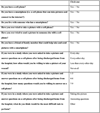Conceptualizing smartphone use in outpatient wound assessment: patients' and caregivers' willingness to use technology
- PMID: 26025626
- PMCID: PMC4530044
- DOI: 10.1016/j.jss.2015.05.011
Conceptualizing smartphone use in outpatient wound assessment: patients' and caregivers' willingness to use technology
Abstract
Background: Information technology is transforming health care communication. Using smartphones to remotely monitor incisional wounds via digital photos as well as collect postoperative symptom information has the potential to improve patient outcomes and transitional care. We surveyed a vulnerable patient population to evaluate smartphone capability and willingness to adopt this technology.
Methods: We surveyed 53 patients over a 9-mo period on the vascular surgery service at a tertiary care institution. Descriptive statistics were calculated to describe survey item response.
Results: A total of 94% of recruited patients (50 of 53) participated. The cohort was 50% female, and the mean age was age 70 y (range: 41-87). The majority of patients owned cell phones (80%) and 23% of these cell phones were smartphones. Ninety percent of patients had a friend or family member that could help take and send photos with a smartphone. Ninety-two percent of patients reported they would be willing to take a digital photo of their wound via a smartphone (68% daily, 22% every other day, 2% less than every other day, and 8% not at all). All patients reported they would be willing to answer questions related to their health via a smartphone. Patients identified several potential difficulties with regard to adopting a smartphone wound-monitoring protocol including logistics related to taking photos, health-related questions, and coordination with caretakers.
Conclusions: Our survey demonstrates that an older patient cohort with significant comorbidity is able and willing to adopt a smartphone-based postoperative monitoring program. Patient training and caregiver participation will be essential to the success of this intervention.
Keywords: Remote technology; Telehealth; Telemedicine; Transitions in care; Wound care; mHealth.
Copyright © 2015 Elsevier Inc. All rights reserved.
Conflict of interest statement
The Authors declare that there is no conflict of interest.
Figures







References
-
- Mangram AJ, Horan TC, Pearson ML, Silver LC, Jarvis WR. Guideline for Prevention of Surgical Site Infection, 1999. Am J Infect Control. 1999;27:97–134. - PubMed
-
- National Nosocomial Infections Surveillance (NNIS) System Report, data summary from January 1992 through June 2004, issued October 2004. Am J Infect Control. 2004;32:470–485. - PubMed
-
- Kirkland K, Briggs J, Trivette S. The impact of surgical-site infections in the 1990s: attributable mortality, excess length of hospitalization, and extra costs. Infect Control Hosp Epidemiol. 1999;20:725–730. - PubMed
-
- Engelbert TL, Fernandes-Taylor S, Gupta PK, Kent KC, Matsumura J. Clinical characteristics associated with readmission among patients undergoing vascular surgery. J Vasc Surg. 2014;59:1349–1355. - PubMed
Publication types
MeSH terms
Grants and funding
LinkOut - more resources
Full Text Sources
Other Literature Sources
Medical

